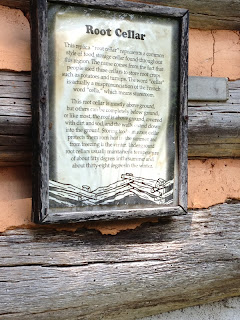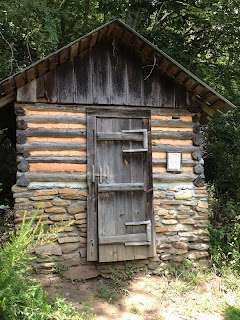FOXFIRE
Foxfire, a phosphorescent lichen, a tiny organism that glows in the dark and is frequently seen in the shaded coves of these Appalachian mountains.
In 1966 Brooks Eliot Wigginton accepted a job in Raburn County where he found teaching high school English students an educational and disciplinary challenge. Reflecting back on some of his own boring lecture classes in high school, he decided to engage them and hopefully increase their desire to learn by starting their own magazine. It needed to be something relevant that would sell so he assigned students to go home and begin interviewing their relatives about planting by the moon signs. These conversations led to superstitions, home remedies,weather signs, and other stories. As they collected these stories, a name was needed for the magazine. Each student submitted 3 titles which students then voted on and that's how "foxfire" began.
Thursday we headed to Mountain City in north Georgia to visit the Foxfire Museum and Heritage Center. We have the first five Foxfire publications so I was familiar with many of the stories and to walk the paths that led us to each restored building and experience the history made it all come alive. In relating her story to us, the Cherokee woman at the Gate House told us that her family escaped walking the Trail of Tears because they were able to hide out deep in the mountains.
The Savannah House built in 1820's by Irish immigrants measures about 21' X 21' and at one time housed ten children and their two parents. Young toddlers would have slept downstairs with their parents or on a trundle bed while older children slept up in the loft.
I was fascinated by the primitive wooden hinges and door latch. It brings to light how people made do and created what they needed with materials at hand.
Working garden where crops were labeled according to use and best planting methods. There were sections for medicinal herbs, plants used for dyeing materials, and, of course, the inseparable three sisters for inter-planting. Corn, beans, and squash complimented each other and provided long-term soil fertility.
At the Gott Cabin, I spent some time talking with the broom maker. She has been making brooms since her teenage years. The broom hanging on the door is her yard sweeper, a real functioning broom made with birch twigs. Instead of raking, she sweeps her shavings into the woods. Lining the walls of the cabin was an amazing variety of crafted brooms, all functional, and capable of lasting many years. Some made from dried corn husks, but mostly from broom corn. Next time I visit, I'll purchase a couple.
Yes, that's a corset hanging over the stove. Was it a subtle reminder about portion size? Considering they cooked with lard, it hardly matters.
We spent a couple of hours walking up and down steep trails trying to absorb the history of the people. This is definitely a place I'll return to with visitors to share this early Southern Appalachian experience.
Foxfire, a phosphorescent lichen, a tiny organism that glows in the dark and is frequently seen in the shaded coves of these Appalachian mountains.
In 1966 Brooks Eliot Wigginton accepted a job in Raburn County where he found teaching high school English students an educational and disciplinary challenge. Reflecting back on some of his own boring lecture classes in high school, he decided to engage them and hopefully increase their desire to learn by starting their own magazine. It needed to be something relevant that would sell so he assigned students to go home and begin interviewing their relatives about planting by the moon signs. These conversations led to superstitions, home remedies,weather signs, and other stories. As they collected these stories, a name was needed for the magazine. Each student submitted 3 titles which students then voted on and that's how "foxfire" began.
Thursday we headed to Mountain City in north Georgia to visit the Foxfire Museum and Heritage Center. We have the first five Foxfire publications so I was familiar with many of the stories and to walk the paths that led us to each restored building and experience the history made it all come alive. In relating her story to us, the Cherokee woman at the Gate House told us that her family escaped walking the Trail of Tears because they were able to hide out deep in the mountains.
The Savannah House built in 1820's by Irish immigrants measures about 21' X 21' and at one time housed ten children and their two parents. Young toddlers would have slept downstairs with their parents or on a trundle bed while older children slept up in the loft.
clay chinking and dovetail notches
inside the wagon shed
The wagon shed houses the Zuraw Wagon and the Judd Nelson Wagon. The Zuraw Wagon is the only documented wagon known to have traveled to Oklahoma in the Trail of Tears. The wagon wheels were greased about every 30 miles or the wheels would seize up.
The term "cellar" is actually a mispronunciation of the French, "cella," which means "storeroom." "Root" cellar refers to storage of root vegetables like potatoes and turnips.
The Chapel
The tour took us up very narrow steep paths with large tree roots jutting through the hard-packed clay. Because of the deep-seated community loyalty of Appalachian people, no one would sell or give away their local church. Whenever a new community developed, the church was the first building constructed as it served as church, schoolhouse, and meeting hall. Foxfire modeled this chapel after one that stood outside Waynesville, NC. using logs salved from the Hunter barn. The students constructed the puncheon benches inside using hand tools. Interior paneling is "wormy" chestnut, now nearly extinct due to a shrubbery blight imported through NY Harbor in the early 1900's. This loss of prime lumber and native food was devastating to the Appalachian people and wildlife.
stained glass inside the chapel
on the outside
infant and adult-size coffins
With a temperate rainforest climate, this unique corner of Appalachia is home to more than 150 different flowers and plants. During August and September, black-eyed Susans were plentiful. I was fascinated by the primitive wooden hinges and door latch. It brings to light how people made do and created what they needed with materials at hand.
Smokehouse used for curing meats.
Working garden where crops were labeled according to use and best planting methods. There were sections for medicinal herbs, plants used for dyeing materials, and, of course, the inseparable three sisters for inter-planting. Corn, beans, and squash complimented each other and provided long-term soil fertility.
At the Gott Cabin, I spent some time talking with the broom maker. She has been making brooms since her teenage years. The broom hanging on the door is her yard sweeper, a real functioning broom made with birch twigs. Instead of raking, she sweeps her shavings into the woods. Lining the walls of the cabin was an amazing variety of crafted brooms, all functional, and capable of lasting many years. Some made from dried corn husks, but mostly from broom corn. Next time I visit, I'll purchase a couple.
Yes, that's a corset hanging over the stove. Was it a subtle reminder about portion size? Considering they cooked with lard, it hardly matters.
We spent a couple of hours walking up and down steep trails trying to absorb the history of the people. This is definitely a place I'll return to with visitors to share this early Southern Appalachian experience.
























Comments